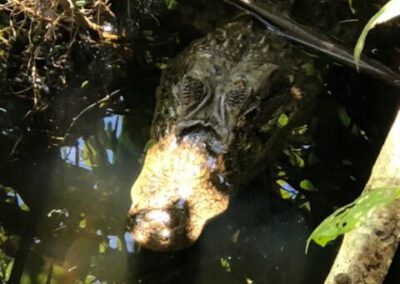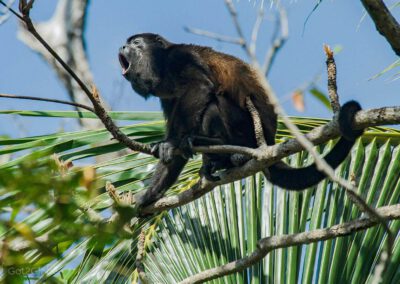Contents
- 1 Cahuita Snorkeling | Cahuita National Park Hike | Full Day Tour
- 1.1 Cahuita National Park | Snorkeling and Hike Tour
- 1.2 Cahuita Snorkeling and Cahuita National Park Hike | Full Day Tour
- 1.3 Cahuita Snorkeling and Cahuita National Park Hike | Full Day Tour
- 1.4 Cahuita Snorkeling and Cahuita National Park Hike | Full Day Tour
- 1.5 Take your Camera – Make your Snorkeling Underwater Video Memory
Cahuita Snorkeling | Cahuita National Park Hike | Full Day Tour
Cahuita snorkeling is the best of Costa Rica snorkeling; guided by local experienced and motivated tour guides, you discover the astonishing marine life of the Reef of Cahuita National Park.
The reef is probably the most beautiful in Costa Rica, with over 35 types of corals and over 100 species of tropical fish, turtles, and even some sharks.
Afterward, enjoy your hike trip and meet the Mammals of the Cahuita National Park, en encounter lots of species, like monkeys, sloths, iguanas, lizards, snakes, and more, and do not forget the fantastic flora, fauna, and the old giant trees.
Cahuita Snorkeling and Cahuita National Park Tour – What to expect?
We start at 8:30 am from the small port of Cahuita. Miss Edith’s restaurant is our rendezvous point. Snorkeling equipment will be provided before boarding the boat, which takes us to Punta Cahuita; this part of Cahuita National Park is 3.5 miles from the Cahuita entrance.
From there, you can snorkel in different places and explore the surroundings, usually two sessions of about 40 minutes each. In the water, you will follow a guide, a Cahuita native and nature specialist/tour guide, who will explain the coral reef system and show you its lush wildlife.
There are many fish species to be observed since this is a natural nursery. You might even run into a Sea Turtle as they feed on the grass. If you are interested in turtles, visit the Turtle Rescue Foundation of Cahuita.
After snorkeling, we stop at Punta Cahuita, where you can relax, unwind and observe an incredible landscape while enjoying a local Costa Rican lunch, fresh fruits & chocolate.
After the break, we go off to discover the national park of Cahuita overland, and this is an excellent opportunity to encounter and observe even more animals as we wander through this impressive landscape and the rich flora and fauna.
Animals such as capuchin and howler monkeys, sloths, snakes, frogs, reptiles, and birds are excellent assets to all the ocean life we just emerged from.
Duration
Approximately: 5 hours [with 2 sessions of about 40 minutes of snorkeling]. The rest of the tour is a hike at Cahuita National Park.
What to bring with you?
Sunscreen, swimming suit, towel, bottle of water, wind jack for the boat trip. For the hike, bug spray, good footwear and of course your camera.
Our Tour guides
Our guides are genuinely local and experienced tour professionals. They harbor a sincere and profound passion for nature and wildlife, deeply respect Costa Rican culture, are thoroughly prepared, and are licensed by the ICT (Costa Rican Tourism Institute).
Pricing
For pricing, see the shop product page and the “Additional Information” Tab; minimum group size [adults] = two persons.
What is included
The use of snorkeling gear, fresh fruit, and a local, experienced tour guide. A private snorkeling guide is optional. Please take a look at the product page.
Meeting Point and Directions
Snorkeling house next to the small harbor [entrance to Marine Park of Cahuita].
About Cahuita National Park
The Cahuita National Park is located at the Southern part of the Caribbean Coast of Costa Rica, and was founded in 1978. It is still the only national park in Costa Rica that depends exclusively on donations.
These are used to keep the park in the best possible condition, free of pollution, and to ensure the safety of the wildlife and visitors. A variety of adventurous, wildlife, hiking and trekking tours are offered by our tour guides.
Wildlife
Cahuita National Park is home to numerous species of wildlife. Among the more common mammals are armadillos, raccoons, sloths, howler monkeys, and capuchin monkeys. There are many species of reptiles and amphibians, including blue jeans dart frogs and red-eyed-leaf frogs, green iguanas, whip-tailed lizards, green vine snakes, and boa constrictors.
Perhaps the most notable reptile is the yellow eyelash pit viper, which has a brilliant golden-yellow color. Many birds inhabit the park, including keel-billed and chestnut mandible toucans, fiery-billed aracaris, oropendolas, parakeets, parrots, herons, egrets, and more.
Cahuita Snorkeling at The Protected Reef of Cahuita National Park
The reef in the Cahuita National Park is protected and can only be visited with the assistance of tour guides with a permit.
It is the largest fringing reef in the Caribbean in the country. The most popular is that it contains over 500 acres of Coral Reef.
This reef consists of three barriers; the outer barrier stretches for 3 miles from the Western side of Punta Cahuita to the Eastern side; it is separated from the coast between 100 meters and 1.5 miles.
Between this barrier and the coast, there is a small fringing reef, about 0.5 miles long and within 100 meters from the shore, called the inner crest. Finally, a 100-meter barrier is located at the Western end of the reef. Patch reefs are found within the lagoon and carbonate banks offshore.
It is a nesting ground for sea turtles, but that is not all you will see if you go scuba-diving or snorkeling. The Reef has over 240 marine life, including tropical fish species, sea urchins, cucumbers, mollusks, and crustaceans.
Best Snorkeling in Costa Rica, First of top 3 Reefs of Costa Rica
Although the reef has shrunk recently, it remains one of Costa Rica’s most popular marine attractions. Cahuita snorkeling is ranked the highest and best snorkeling in Costa Rica.
Cahuita is the best place in case and close if you are interested in snorkeling Puerto Viejo.
The coral reefs are built by living organisms: the corals. These animals have a skeleton made of calcium carbonate and are associated with algae which produce the food (by photosynthesis).
The Coral reefs are among the most productive environments in the world, and they are essential not only as carbon sinks but also for marine life reproduction.
Costa Rica has coral reefs on both coasts. The most developed reefs are on the South Atlantic coast, from Moín to Punta Mona, and cover about 10 square miles.
The Cahuita National Park protects the most remarkable coral reef on the Caribbean coast, and it has been one of the most studied.
The largest fringing reef of the Caribbean in the country is indeed located at the Cahuita National Park.
The coral reef at Cahuita has been degrading during the last 30 years due to siltation, other anthropogenic impacts, and natural causes (some exacerbated by human activity): massive death of organisms, earthquakes, and warming events.
Although these facts, the Cahuita Reef is still beautiful, and as it is protected, you will find 35 coral species, including the light yellow brain, elkhorn, and blue staghorn species.
Marine Life
Marine life, sea life, or ocean life are the plants, animals, and other organisms that live in the salt water of the sea or ocean or the salty water of coastal estuaries.
At a fundamental level, marine life affects the nature of the planet. Aquatic organisms, primarily microorganisms, produce oxygen and sequester carbon.
Marine life partly shapes and protects shorelines, and some marine organisms even help create new land (like coral-building reefs). Most life forms evolved initially in marine habitats.
By volume, oceans provide about 90% of the living space on the planet. The earliest vertebrates appeared in the form of fish, which live exclusively in water. Some evolved into amphibians, who spend portions of their lives in water and on land.
One group of amphibians evolved into reptiles and mammals, and a few subsets of each returned to the ocean as sea snakes, sea turtles, seals, manatees, and whales. Plant forms such as kelp and other algae grow in the water and are the basis for some underwater ecosystems.
Plankton establishes the general foundation of the ocean food chain, particularly phytoplankton, which are key primary producers.
Marine invertebrates exhibit many modifications to survive in poorly oxygenated waters, including breathing tubes, as in mollusk siphons.
Fish have gills instead of lungs, although some fish species, such as lungfish, have both. Marine mammals (like dolphins, whales, otters, and seals) must surface periodically to breathe air.
The Cahuita Reef has over 500 fish species, including three types of sharks, which you might encounter while snorkeling. And you will meet a dozen marine life of other fish species like dolphins, stingrays, blue parrot fish, angelfish, manta rays, rock beauty, the French angelfish, and even the dangerous scorpion fish.
Cahuita Snorkeling and encounter with Turtles
The most common sea turtles in Costa Rica are The Leatherbacks (which are quite rare around Cahuita, besides ‘Big Beach’). Most often, you will encounter the Hawks bill or ‘Carey’ and the Green Turtle, which nest on the Caribbean coast.
The Hawksbill turtles, nest in Cahuita National Park from September to January, and the hatching period is approximately from January to March.
There is a good chance during a snorkeling trip; you will get encountered these amazing marine creatures.
Cahuita has its own rescue center to promote the protection and survival of sea turtles. They act as a community protector of the native wildlife in the area, therefore ensuring the survival of the sea turtles and guarding of the natural treasures.
The Turtle Rescue Center of Cahuita works with volunteers from the Local Community of Cahuita and Biologists. Worth a visit. Our tour guides are eager to show you directions where to go, or accompany you, to show the work of this foundation. We recognize ourselves as part of the ecosystem and the guarantors of its balance.
The most common sea turtles in Costa Rica are The Leatherbacks (which are quite rare around Cahuita, besides ‘Big Beach’). Most often, you will encounter the Hawks bill or ‘Carey’ and the Green Turtle, which nest on the Caribbean coast.
The Hawksbill turtles, nest in Cahuita National Park from September to January, and the hatching period is approximately from January to March.
There is a good chance during a snorkeling trip; you will get encountered these amazing marine creatures.
Cahuita has its own rescue center to promote the protection and survival of sea turtles. They act as a community protector of the native wildlife in the area, therefore ensuring the survival of the sea turtles and guarding of the natural treasures.
The Turtle Rescue Center of Cahuita works with volunteers from the Local Community of Cahuita and Biologists. Worth a visit. Our tour guides are eager to show you directions where to go, or accompany you, to show the work of this foundation. We recognize ourselves as part of the ecosystem and the guarantors of its balance.
Cahuita National Park | Snorkeling and Hike Tour


Take your Camera – Make your Snorkeling Underwater Video Memory
A video made by a traveler during the full-day combo snorkeling and hike tour at Cahuita Nationals Park. The Video is made at the protected coral reef of Costa Rica. Snorkeling in the Marine park of Cahuita is the best snorkeling spot in Costa Rica.



















